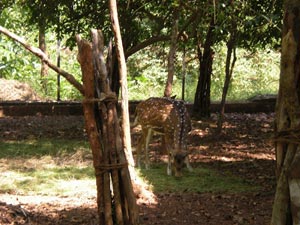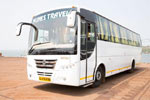Cotigao Wildlife Sanctuary

The southernmost National Park of Goa covers an area of 86 square kilometers on the border with the neighboring state of Carnataka and on the banks of two rivers — Talpona and Galjibaga.
Cotigao Wildlife Sanctuary was established in 1969 to protect a remote and vulnerable area of forest lining the Goa- Karnataka border. It is the second largest National Park in Goa. This wonderful wildlife kingdom is located in Cancona region (Cancona Taluk), just 10 km from the City of Chaudi and Palolem Beach resort. The nearest town to Cotigao Wildlife Sanctuary is Poinguinim which is situated 2 km from the main entry to the Park. All passing-by buses are stopping there, but it is anyway better to have your own car or at least to take a car for rent.
Cortigao National Park is primarily known for its ultra-high (30 meters!) trees with so much heavy cover, that sometimes do not even access the sun light onto the earth surface. 18 meters moving stairways are given the most brave tourists the chance to climb up the high tree for watching breathtakingly beautiful sightseeing which stands before an eye from the top of trees. Forest vegetation in Cotigao is represented by three main types: deciduous, semi-evergreen and evergreen.
The fauna of Cotigao Wildlife Sanctuary is very varied. Here you can find such incredible representatives of the Indian fauna as Muridae deer, giant Indian flying squirrel, four-horn antelope, Lesser Grey Nuthatch, gaur (Indian bison), bison, Black Panther, porcupine, leopard and many other animals. You shouldn’t expect, however, that you would simply meet them while taking a walk through one of eight five-kilometer touristic paths of the National Park. It is better to climb the observation tower from which you would be able to see animals’ watering place and the amazing huge Cotigao Wildlife Sanctuary territory. Wait a little bit and you would be awarded: lots of fauna representatives will appear in front of your eyes. On Cotigao Wildlife Sanctuary territory there is also a watchtower that was built here in the XVI century.
The sanctuary is best visited between the months of October and March. You can visit the National Park everyday from 7:00 am till 5:30 pm. The admission ticket costs 5 rupees, plus you will need to pay about 25 rupees for a camera.
Written permission for an overnight stay, either in the watchtower or the forest department's small rest house must be obtained from the Deputy Conservator Of Forests, 3rd Floor, Junta House, Panaji, as far in advance of one's visit as possible.




